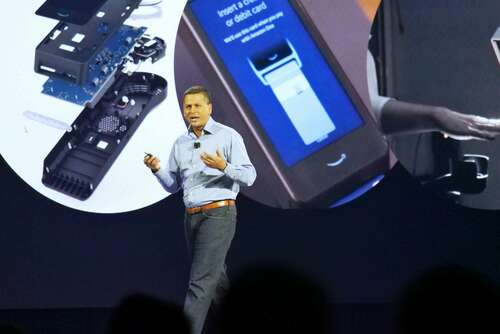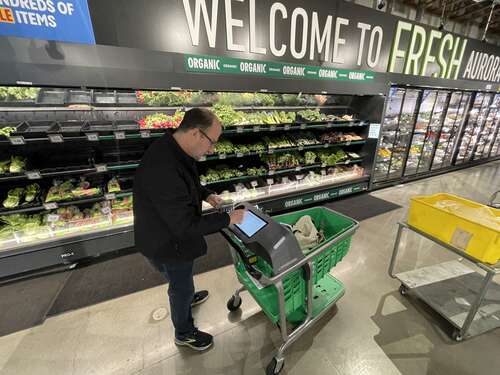
Amazon’s grocery technology has been in the news a lot over the past couple of weeks, following layoffs in the Amazon Web Services group responsible for the company’s physical store checkout and identity services.
The company is shifting away from “Just Walk Out” in its large grocery stores, which uses cameras and sensors to detect what people put in their carts, letting them avoid the checkout line. Instead, it’s focusing on Dash Carts, which also let shoppers skip the line but currently require scanning or manually entering items as they go.
Dilip Kumar, vice president of AWS applications, spoke with GeekWire in an interview about Amazon’s grocery technology, seeking to clarify the company’s strategy and approach on multiple fronts. Specifically, he said:
- Amazon is developing a new generation of its Dash Carts that significantly improve the user experience, addressing some of the more cumbersome aspects of using the smart carts in its grocery stores.
- The company is still investing in and expanding the Just Walk Out cashier-less technology for its smaller stores and third-party venues, even as it phases the technology out at its larger Amazon Fresh grocery stores.
- Contrary to published reports, humans are annotating and training the AI that powers Just Walk Out, not watching through cameras to tally up every shopper’s bill. And the number of people required is diminishing.
“Our algorithms have actually increased to the level of accuracy … where the amount of human involvement progressively has gone down,” Kumar said. “We see this trend continuing. That’s the only reason that allows us to be able to open as many of these stores concurrently.”
In a blog post Wednesday morning, Kumar described media reports about human reviewers “erroneous,” saying that the idea that Just Walk Out technology “relies on human reviewers watching from afar is untrue.” He added:
“Most AI systems, including the underlying ML models behind these technologies, are continuously improved by annotating synthetic (AI generated) and real shopping data. Our associates are responsible for this labeling and annotation step. Associates don’t watch live video of shoppers to generate receipts—that’s taken care of automatically by the computer vision algorithms. This is no different than any other AI system that places a high value on accuracy, where human reviewers are common.”
He cited examples of increased transactions and sales at venues using Just Walk Out, including Lumen Field in Seattle and other U.S. and international markets.
“We have strong conviction that Just Walk Out technology will be the future in stores that have a curated selection where customers can pop in, grab the small number of items they need, and simply walk out,” Kumar wrote. There are more than 140 third-party venues using the tech in the U.S., UK, Australia, and Canada, he added.
So why is Amazon dropping Just Walk Out at its large grocery stores?
In the interview, Kumar acknowledged the significant cost of the Just Walk Out infrastructure in these settings, with a large number of cameras and sensors required throughout the store. Rather than requiring a fixed investment based on the size of the store, Dash Carts can scale with the number of customers.
The decision to focus on the Dash Carts also aligns with customer preferences in that retail format, he said. Many customers in grocery stores place more value on tracking their spending as they go, seeing item locations, and using coupons. These features are better supported by the smart cart experience.
In addition, for larger trips to the grocery store, many people aren’t as focused on shaving a few minutes off their time in the store, and they’re more interested in the other conveniences of the Dash Cart.
Amazon’s Dash Cart features built-in sensors and scanners that let shoppers register items as they place them in the cart. A built-in screen tracks and totals items.
Kumar wrote in the blog post that Amazon has “begun expanding Dash Cart to all Amazon Fresh stores as well as third-party grocers.” CNBC reported that Price Chopper and McKeever’s Market stores in Kansas and Missouri are testing the Dash Cart.
The smart cart debuted in 2020 at Amazon Fresh grocery stores, and has since expanded to some Whole Foods stores. Other companies including Instacart and Seattle startup Veeve have rolled out similar smart carts.
Amazon decided that the Dash Cart “is a better platform for continued investment,” but the decision doesn’t deter from its plans for Just Walk Out in other Amazon stores or third-party locations, Kumar said.

During the interview, we shared some of our frustrations with the current version of the Dash Cart, including the complicated and sometimes buggy process of scanning or entering items into the cart. Kumar said he appreciated the feedback, and made it clear that Amazon is aware of the issues as it develops the next version of the cart.
An Amazon spokesperson provided additional details in a statement.
“With our next generation of Amazon Dash Carts, once a customer signs in (or chooses to shop without signing in), they’ll shop with a smart cart that feels as familiar as a traditional shopping cart. Our next generation cart will be lighter and easier to maneuver, and have a bigger basket to fit all your purchases. Adding items to the cart will be even more intuitive, and for customers who don’t sign in with an app, the cart will feature an on-cart credit card reader.”
The company did not give a timeline for rolling out new versions of the cart.
“Our goal with this is to make this as effortless and seamless as it possibly can be,” Kumar told us. “We’ve seen some good signs. … And I hope to convert you.”

